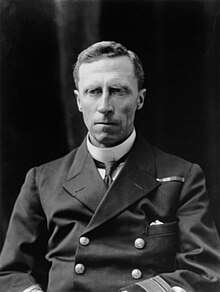Cecil Frederick Dampier
Cecil Frederick Dampier | |
|---|---|
 Photographed by Walter Stoneman in 1918 | |
| Born | 11 May 1868 |
| Died | 11 April 1950 (aged 81) Gloucester, England |
| Allegiance | |
| Service/ | |
| Rank | Admiral |
| Commands held | Cambridge Audacious |
| Battles/wars | First World War |
| Awards | Companion of the Order of St Michael and St George |
Admiral Cecil Frederick Dampier CMG (11 May 1868 – 11 April 1950) was a Royal Navy officer during the First World War.
[edit]
Dampier entered the Royal Navy and was promoted to the rank of Commander on 1 January 1900.[1]
He was posted to the gunnery ship Cambridge off Plymouth on 27 May 1902.[2]
He was captain of Audacious, which spent her entire career assigned to the Home and Grand Fleets. She was sunk by a German mine off the northern coast of County Donegal, Ireland, in October 1914.[3]
Dampier was Second-in-Command of a Battle Squadron during the early parts of the First World War, and Admiral-Superintendent at Dover in 1917.[4]
In May 1918 he was involved in remote control trials of unmanned aerial vehicles by the Royal Navy's D.C.B. Section.[5]
He was appointed a Companion of the Order of St Michael and St George (CMG) in the 1919 New Year Honours.[6]
References[edit]
- ^ "No. 27150". The London Gazette. 2 January 1900. p. 3.
- ^ "Naval & Military intelligence". The Times. No. 36769. London. 16 May 1902. p. 11.
- ^ Brown, David K. (2003). The Grand Fleet: Warship Design and Development 1906–1922 (reprint of the 1999 ed.). London: Caxton Editions. p. 161. ISBN 1-84067-531-4.
- ^ Dampier Service Record. ADM 196/42. f. 497.
- ^ UK National Archives ADM 1/8539/253 Capabilities of distantly controlled boats. Reports of trials at Dover 28 - 31 May 1918
- ^ "No. 31099". The London Gazette (Supplement). 1 January 1919. p. 109.
